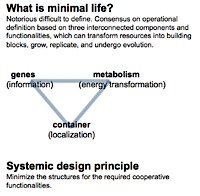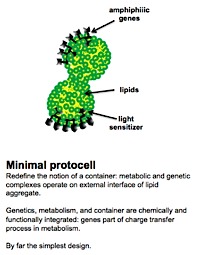The design principle behind our protocell is simple (Rasmussen et al., 2003): Minimize the number and complexity of the physico-chemical structures for the required cooperative functionalities. The minimal protocell we seek to implement consists of a particular coupling between the three central components: the genetic material (information), a metabolic system (energy transformation), and a container (co-localization). Because simplicity is our main goal, we are not restricted to contemporary cellular structures or building blocks. Two ideas have been important to the design:
- We have simplified the notion of a container by allowing the metabolic and genetic complexes to operate at the external interface of a (fatty acid) lipid or (oil) droplet aggregate, as well as within the aggregate itself. The genes incorporate amphiphilic genes (backbone modified peptide nucleic acid (PNA) or DNA with hydrocarbon tails) and the metabolic molecules are hydrophobic photo-sensitizers, either an organic dye (stilbene) or organo-metallic (Ru-bpy) structures with hydrocarbon tails. All of the protocell components are designed to self-assemble in water.
- We have simplified the cooperativity between genetics, metabolics, and container by integrating genes as a functional component of a charge transfer process (electron donor) of the metabolism, which means that the genes directly catalyze the metabolic process. The metabolism produces the container components (as well as the other building blocks), which in turn self-assemble into an aggregate, which in turn contains the metabolism and the genes as well as catalyze the gene self-replication and the metabolic processes.
Accepting the above design concepts allow us to explore protocells which are functionally much simpler than modern biological cells and containers as small as a few nanometers in diameter and thus orders of magnitude smaller than contemporary cells.
A full physical mesoscale simulation of a micellar protocell life-cycle of the Los Alamos Bug was constructed.
S. Rasmussen, L. Chen, M. Nilsson, and S. Abe, Bridging nonliving and living matter, Artificial Life 9 (2003) 269.







